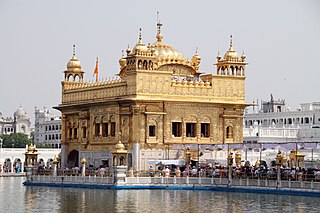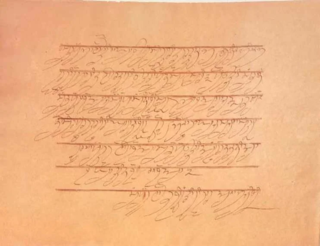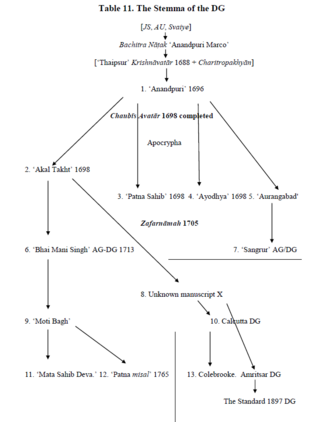
Sikhism, also known as Sikhi, is a monotheistic religion and philosophy that originated in the Punjab region of the Indian subcontinent around the end of the 15th century CE. It is one of the most recently founded major religious groups and among the largest in the world with about 25–30 million adherents.

Guru Gobind Singh was the tenth and last human Sikh Guru. He was a warrior, poet, and philosopher. In 1675, at the age of nine he was formally installed as the leader of the Sikhs after his father Guru Tegh Bahadur was executed by Emperor Aurangzeb. His father was the ninth Sikh Guru. His four biological sons died during his lifetime – two in battle and two executed by the Mughal governor Wazir Khan.

The Guru Granth Sahib is the central holy religious scripture of Sikhism, regarded by Sikhs as the final, sovereign and eternal Guru following the lineage of the ten human gurus of the religion. The Adi Granth, its first rendition, was compiled by the fifth guru, Guru Arjan (1564–1606). Its compilation was completed on 29 August 1604 and first installed inside the Golden Temple in Amritsar on 1 September 1604. Baba Buddha was appointed the first Granthi of the Golden Temple. Shortly afterwards Guru Hargobind added Ramkali Ki Vaar. Later, Guru Gobind Singh, the tenth Sikh guru, added hymns of Guru Tegh Bahadur to the Adi Granth and affirmed the text as his successor. This second rendition became known as the Guru Granth Sahib and is also sometimes referred to as the Adi Granth.

Gurbani is a Sikh term, very commonly used by Sikhs to refer to various compositions by the Sikh Gurus and other writers of Guru Granth Sahib. In general, hymns in the central text of the Sikhs, the Guru Granth Sahib, are called Gurbani. Among Amritdhari Sikhs, a few texts from Dasam Granth which are read as Nitnem, like Tav-Prasad Savaiye and Chaupai, are also considered Gurbani. In Adi Granth, Gurbani is a sound which comes directly from the Supreme and the text is a written form of the same in worldly language and scripts. It is also called Guru’s Bani. Gurbani are explanations of qualities of the Primal Lord and Soul which a Sikh should comprehend and with which they can attain the supreme state.

The Dasam Granth is a collection of various poetic compositions attributed to Guru Gobind Singh. The text enjoyed an equal status with the Adi Granth, or Guru Granth Sahib, in the eighteenth and nineteenth centuries and were installed side by side on the same platform. The Dasam Granth lost favor during the colonial period when reformist Singh Sabha Movement scholars couldn't contextualize the reworkings of Puranic stories or the vast collection of 'Tales of Deceit' Sri Charitropakhyan.

Kaviyo Bach Benti Chaupai is a hymn by Guru Gobind Singh. Chaupai is the 405th Charitar of the Charitropakhyan composition contained within the Dasam Granth. It forms part of a Sikh's Nitnem and is read during Amrit Sanchar ceremonies.

Japji Sahib (Punjabi: ਜਪੁਜੀ ਸਾਹਿਬ, pronunciation: ) is the Sikh thesis, that appears at the beginning of the Guru Granth Sahib – the scripture of the Sikhs. It was composed by Guru Angad, and is mostly the writings of Guru Nanak. It begins with Mool Mantra and then follow 38 paudis (stanzas) and completed with a final Salok by Guru Angad at the end of this composition. The 38 stanzas are in different poetic meters.

Jaap Sahib is the morning prayer of the Sikhs. The beaded prayers were composed by the Tenth Sikh Guru, Guru Gobind Singh and is found at the start of the Sikh scripture Dasam Granth. This Bani is an important Sikh prayer, and is recited by the Panj Pyare while preparing Amrit on the occasion of Amrit Sanchar (initiation), a ceremony held to Amrit initiates into the Khalsa and it is a part of a Sikh's Nitnem. The Jaap Sahib is reminiscent of Japji Sahib composed by Guru Nanak, and both praise God.

The Ardās is a set prayer in Sikhism. It is a part of worship service in a Gurdwara, daily rituals such as the opening the Guru Granth Sahib for prakash or closing it for sukhasan in larger Gurdwaras, closing of congregational worship in smaller Gurdwaras, rites-of-passages such as with the naming of child or the cremation of a loved one, daily prayer by devout Sikhs and any significant Sikh ceremonies.

The Nihang or Akali, also known as Dal Khalsa, is an armed Sikh warrior order originating in the Indian subcontinent. Nihangs are believed to have originated either from Fateh Singh and the attire he wore or from the "Akal Sena" started by Guru Hargobind. Early Sikh military history was dominated by the Nihang, known for their victories where they were heavily outnumbered. Traditionally known for their bravery and ruthlessness in the battlefield, the Nihang once formed the irregular guerrilla squads of the armed forces of the Sikh Empire, the Sikh Khalsa Army.

The Sarbloh Granth or Sarabloh Granth, also called Manglacharan Puran or Sri Manglacharan Ji, is a voluminous scripture, composed of more than 6,500 poetic stanzas. It is traditionally attributed as being the work of Guru Gobind Singh, the tenth Sikh guru. Scholars, on the other hand, attribute the work to after the Guru's death, being authored by an unknown poet. The work is mostly revered by the Nihang sect.

The principal Sikh scripture is the Adi Granth, more commonly called the Guru Granth Sahib. The second most important scripture of the Sikhs is the Dasam Granth. Both of these consist of text which was written or authorised by the Sikh Gurus.

In Sikhism, God is conceived as the Oneness that permeates the entirety of creation and beyond. It abides within all of creation as symbolized by the symbol Ik Onkar. The One is indescribable yet knowable and perceivable to anyone who surrenders their egoism and meditates upon that Oneness. The Sikh gurus have described God in numerous ways in their hymns included in the Guru Granth Sahib, the holy scripture of Sikhism, but the oneness of formless God is consistently emphasized throughout.

Chandi Di Var also known as Vaar Durga Ki is a composition written by Guru Gobind Singh, included in the 5th chapter of Dasam Granth.

Akal Ustat is the name given to the second Bani present in the second holy scriptures of the Sikhs called the Dasam Granth. It is composed of 271 verses, and is largely devotional in nature.

The history of the Dasam Granth is related to the time of creation and compilation of various writings by Guru Gobind Singh in form of small booklets, some of which are Sikh prayers. The first combined-codex manuscripts of the Dasam Granth were created during the Guru period. It is also said that after 1708, the Dasam Granth was allegedly compiled by Mani Singh Khalsa, contributed by other Khalsa armymen under direct instructions of Mata Sundari and this volume is recognized as Sri Dasam Granth Sahib. The present day Dasam Granth includes Jaap Sahib, Akal Ustat, Bachitar Natak, Chandi Charitar Ukati Bilas, Chandi Charitar II, Chandi di Var, Gyan Prabodh, Chaubis Avtar, Rudra Avtar, 33 Sawaiye, Khalsa Mahima, Shashtar Nam Mala Purana, Ath Pakh-yaan Charitar Likh-yatay and Zafarnamah.

Chaubis Avtar is a composition in Dasam Granth containing history of 24 incarnations (avatars) of Vishnu.
Kara or Kada is a thick metal ring or bracelet usually worn on the hands or wrists of men and women in India. It is a religious bracelet that Sikhs wear. Mostly made of Iron, the kara has different design styles and is usually used to honor a religious figure. Kara is worn by Sikhs who have been initiated into the Khalsa. It is one of the five kakars or five Ks — external articles of faith — that identify a Sikh as dedicated to their religious order. The kara was instituted by the tenth Sikh guru Gobind Singh at the Baisakhi Amrit Sanchar in 1699. Guru Gobind Singh Ji explained:
He does not recognize anyone else except me, not even the bestowal of charities, performance of merciful acts, austerities and restraint on pilgrim-stations; the perfect light of the Lord illuminates his heart, then consider him as the immaculate Khalsa.

Rama, known as Ram Avatar or Raja Ram, is considered an important figure in Sikhism, due to his inclusion as one among the 24 incarnations of Vishnu in the Chaubis Avtar, a composition in the Dasam Granth traditionally and historically attributed to Guru Gobind Singh. The discussion of Rama and Krishna is the most extensive in this section of the secondary Sikh scripture. The composition is martial, stating that the avatar of Vishnu appears in the world to restore good and defeat evil, but asserts that these avatars are not God, but agents of the God. God is beyond birth and death. The famous Savaiya and Dohra from the Rehras Sahib, read daily by devout Sikhs, comes from Ram Avatar Bani. However, it is not to be confused with Sikhs believing or worshipping Raja Ram or Krishan. It is clear from Guru Gobind Singh's verses in Chaupai Sahib, a part of Sikh Nitnem, or daily prayer.

Anandpur Lipi is a calligraphic style of the Gurmukhi script associated with Guru Gobind Singh. It is commonly found among early manuscripts of the Dasam Granth scripture as the employed script.


















